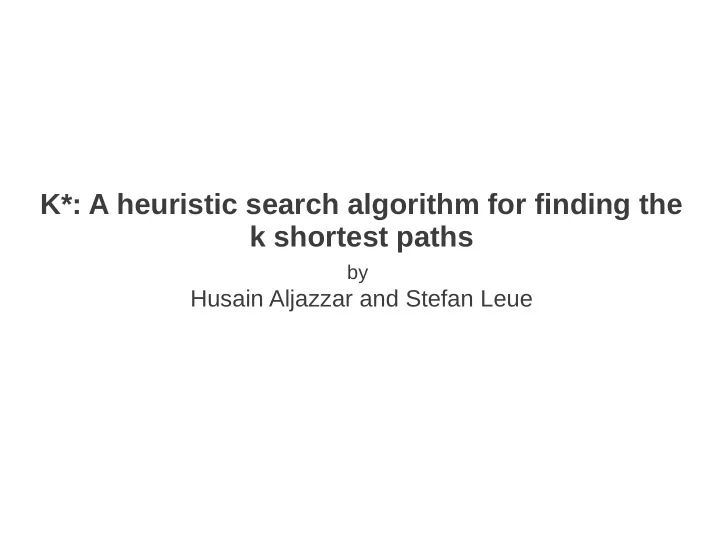

K*: A heuristic search algorithm for finding the k shortest paths by Husain Aljazzar and Stefan Leue
The task ● Finding K shortest paths ● Many algorithms – state of art by Eppstein (EA) ● Usually assume entire graph explicitly as input ● That's why we don't use those algorithms for graphical models ;)
The task ● Finding K shortest paths ● Many algorithms – state of art by Eppstein (EA) ● Usually assume entire graph explicitly as input ● That's why we don't use those algorithms for graphical models ;) ● Aljazzar and Leue: graph is not explicit, parts of it are generate “on-the-fly” while exploring (using current state and successor function) ● Which is closer to what we are doing
Very high-level comparison of K* to our m-A* ● m-A* ● K* ● No explicit graph ● No explicit graph ● 1 starting node, 1 target ● 1 starting node, any node number of target nodes ● ● Paths found don't have ● Paths found might have loops loops ● Very simple concept ● More complicated procedure, involves a very fancy datastructure
K* at a glance ● A* is used to explore the problem graph , until the best path to the goal is found – search tree is constructed in the process ● All sidetrack edges (i.e. not on the best path) are stored in path graph (using a heap-based data structure) ● A path in the path graph (of any length) has a one to one correspondence to a path in the problem graph (and the latter can be easily reconstructed from the former) ● Path graph is searched, using Dijkstra's algorithm ● It is shown that the shortest path in path graph corresponds to the 2 nd best path in the original graph, 2 nd shortest in the in the path graph to the 3 rd best in the original etc. ● If we don't have k solutions after searching entire path graph – we use A* to further explore original graph and add new sidetrack edges to the path graph. - we keep interleaving A* and Dijkstra
K* at a glance ● A* is used to explore the problem graph , until the best path to the goal is found – search tree is constructed in the process ● All sidetrack edges (i.e. not on the best path) are stored in path graph (using a heap-based data structure) ● A path in the path graph (of any length) has a one to one correspondence to a path in the problem graph (and the latter can be easily reconstructed from the former) ● Path graph is searched, using Dijkstra's algorithm ● It is shown that the shortest path in path graph corresponds to the 2 nd best path in the original graph, 2 nd shortest in the in the path graph to the 3 rd best in the original etc. ● If we don't have k solutions after searching entire path graph – we use A* to further explore original graph and add new sidetrack edges to the path graph. - we keep interleaving A* and Dijkstra Complexity O(m+n log n+k)
K* And now with more details...
Search tree computed by A* and sidetrack edges If we have a sidetrack sequence <(s1,s2),(s2,s4)>, we can reconstruct the path s0s1s2s4
Detour cost ● For an edge (u, v) , the detour function δ(u, v) represents the cost disadvantage entailed by taking the detour edge (u, v) in comparison to the shortest s–t path via v
Path graph On the high level – it's a graph: nodes represent sidetrack edges of the ● original graph Has very complicated structure – several interconnected heaps, ordered by ● detour costs Edges are weighted:
Path graph P(G), properties ● Path graph is a directed weighted graph ● nodes represent sidetrack edges of the original graph ● edges are weighted, all weights are non-negative: ● ● ● Each node has at most 4 outgoing edges (allows to bound complexity of Dijkstra) ● An arbitrary path σ = n0→· · ·→nr in P(G) can be interpreted as a recipe for constructing a unique s–t path. ● Sidetrack sequence from P(G) always yields a valid s-t path
Example Let σ be the path (s2, s4)→(s1, s2)→(s3, s2). We derive that seq(σ) = <(s3, s2), (s2, s4)>. We construct the corresponding s0–s4 path We start at s4 . The next sidetrack edge in seq(σ) is (s2, s4). We see that we reached the destination vertex of this sidetrack edge, namely s4. Hence, we prepend this sidetrack edge to get the path s2 s4. Again we see that we reached the destination vertex of the next sidetrack edge, namely s2. Hence, we prepend this sidetrack edge to our path to obtain the path s3 s2 s4 . We now have consumed all sidetrack edges and we hence keep prepending tree edges until we reach s0 and finally obtain the path s0 s2 s3 s2 s4.
Example
Properties of K* ● correct and complete for localy finite graphs ● Always terminates on finite graphs (on infinite – only for bounded k) ● For admissible heuristic – s-t paths are found in non-decreasing order of length ● Time and space complexity O(m+ n long n +k) (m edges, n nodes, k solutions)
Experiments: route planning (in New York city) 264,346 nodes and 733,846 edges
Experiments: route planning (in New York city)
Experiments: route planning (in New York city)
Experiments: route planning (Eastern USA) 3,598,623 nodes and 8,778,114 edges.
Experiments: route planning (Eastern USA)
Computing the counterexample for a stochastic model checking problem
Computing the counterexample for a stochastic model checking problem
Computing the counterexample for a stochastic model checking problem
Recommend
More recommend